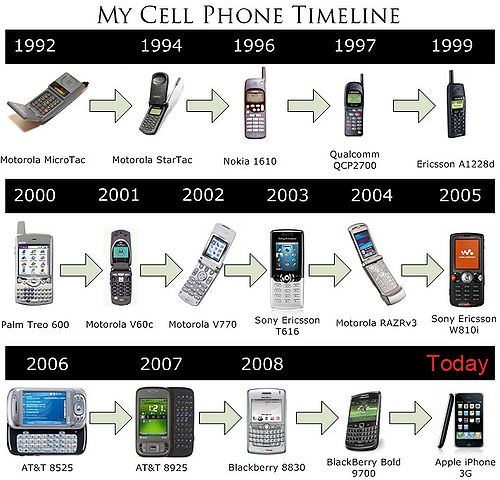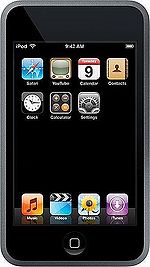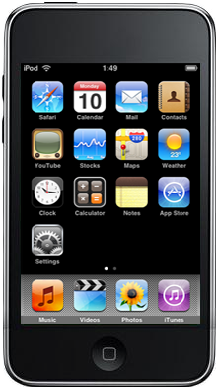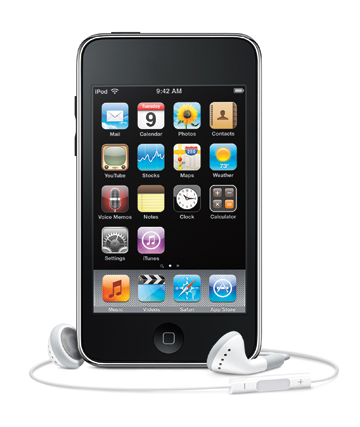Course:ETEC522/2010ST1/MobileTechnologies/Future Potential
Future Potential
by Ritwa Smith(Smartphones and iPod Touch)
Appeal and Significance of SmartPhones and iPod Touch
Models
The iPod Touch has gone through many changes over the years. The changes have to do with its image, capacity, RAM, connectivity and other things. Further details can be found at http://en.wikipedia.org/wiki/IPod_Touch
| 1st Generation | 2nd Generation | 3rd Generation |
|---|---|---|
SmartPhone
The SmartPhone enables users to leave their homes or business and still be connected to the office. As the demand for these phones increases, Mobile Providers have had to offer different plans to users. This includes the ability to make mobile voice calls, data plans that provide wireless Internet service, email, advanced address book and calendar applications, Microsoft Word, Excel, and Access-compatible applications. Also some Mobile Providers offer monthly subscriptions to mobile TV channels. Users are also able to do Multimedia Messaging Service (MMS) which is the enhanced version of SMS text messaging services that allows photos, videos, graphics and sound to be included with a text message transfer. SmartPhones have built-in cameras and video recorders with limited video playback. The processors being used in the SmartPhones have high speeds of around 200MHz, to be expanded. Operating systems active in the SmartPhone market are: Symbian, Windows Mobile OS, Palm OS and Linux. Smartphones use memory which is typically 128MB RAM and 64MB ROM. They also allow wireless connection to the Internet through the data-enabled aspects of the mobile phone network. GPRS (General Packet Radio Service) is the standard technology for accessing high speed data through the mobile phone networks and all SmartPhones support this protocol. This is a different technology to that of WiFi wireless networking. The GPRS system is packet-based, like the Internet’s basic TCP/IP protocol, is always on, and offers speeds of up to 24kb/s. SmartPhones also come equipped with Bluetooth. The future is wireless and it is evident that M-Commerce has replaced E-Commerce and we are now moving from 3G to 4G.
The iPod touch allows users to store and play back digital media even as they are on the go and to store quality video. The iPod touch has hard disc storage of various sizes. This device is able to communicate with different audio formats, Advanced Audio and Windows Media Audio. Users are able to connect the iPod touch to personal computers, home entertainment systems through a range of connectors including FireWire 400, USB 2.0 and MinidDIN sockets for S-Video.
As the demand for these devices increases, the cost of the older ones are decreased, thus making it affordable and accessible to those who are unable to afford the more up to date ones. Also as the demand increases, the manufacturers are able to reduce the price of these items which makes it more affordable for persons in underdeveloped countries.
Do you want to trade in your old iPhone? Read http://news.yahoo.com/s/ytech_gadg/ytech_gadg_tc2535 to find out how.
iPod Touch
The iPod Touch allows users to store and play back digital media even as they are on the go and to store quality video. The iPod Touch has hard disc storage of various sizes. This device is able to communicate with different audio formats, Advanced Audio and Windows Media Audio. Users are able to connect the iPod Touch to personal computers, home entertainment systems through a range of connectors including FireWire 400, USB 2.0 and MinidDIN sockets for S-Video.
As the demand for these devices increases, the cost of the older ones are decreased, thus making it affordable and accessible to those who are unable to afford the more up to date ones. Also as the demand increases, the manufacturers are able to reduce the price of these items which makes it more affordable for persons in underdeveloped countries.
Using Smartphones and iPod touch for Learning
The Smartphone and iPod touch are great devices that can be utilized to aid learning. These devices are able to deliver more content and allow users to use it while on the go (walking, running). There is now easy accessibility to the Internet through various mobile networks which allows the user to interact with the content wherever they are. Through these devices the users are able to interact with the content through, text, voice and video. In using these two devices for learning, they help to enhance the image of the institution, which will in turn attract top students with leading edge technology. This therefore allows the institution to place itself at the top of the market. Through using these technologies, the institution is able to enjoy world-renowned security, so information stays protected and confidential. As the institution uses the tools for learning, they are able to improve campus communications and overall experience. Through the SmartPhones and iPod students are prepared for the work environment with access to real-world technology. The SmartPhone and iPod Touch can be used for Learning in many ways. Have a look at http://edcommunity.apple.com/ali/story.php?itemID=16472
There are also pedagogical reasons to utilize these devices in learning. As educators seek to enhance the teaching and learning experience they have moved towards engaging learners and making them more active through the use of constructivist model. Hence it is suggested that the use of these devices facilitates the implementation of pedagogical practices that matches that of constructivism.
Greatest Potential for Using Smartphones and iPod touch for Learning
With the changes in mobile technologies, the embracing of the technologies and development of the market has placed educational institutions in a precarious position. It has presented an increased need for educators to be aware of, and engaged in, the development of the applications and uses of such devices. It is therefore important for them when making these decisions to be focused on their students. These devices can be used best when:
- Institutions have lack of classroom space
- Students have challenges attending face to face sessions
- Students need information at their fingertips whilst on the go
- Access to lecture even after it has ended
- Students have to travel very far to attend classes
- There are challenges in carrying around material for courses
- Institutions wish to reduce their paper budget
E-readers
by doug larsen
- There has been a dramatic increase in consumer demand for digital content both periodicals and books. Association of American Publishers announced ebook sale revenues increased between 2008 & 2009 by 180.7% - January 2008 – October 2008 46.6 million and January 2009 – October 2009 was 130.7 million; (not including professional markets such as libraries and educational institutions (Kho, 2010)
- Predictions have revenue potentially reaching 500 million in 2010 (Kho, 2010)
- Steve Haber, the head of Sony's digital reading business division stated "Within five years there will be more digital content sold than physical content. Three years ago, I said within ten years but I realized I was wrong - it's within five"(Richard, June 2010)
- Amazon with its Kindle DX is targeting college/university students; it has signed deals with three of the largest text book publishers totaling approximately 60% of the market. Five large American universities, including Princeton, have established a partnership with Amazon to test the device. Students at these institutions received the ereader in courses whose content was available to be used by the device (Reyes, July 2009).
- Mc-Graw-Hill revenues from ebooks is small but rapidly growing revenue in the higher education market (Baumann, May 2010)
- There is a suggestion that "Google will be selling a mammoth multimillion dollar library (Quint, May 2010, pg.7).
- There are notions of changing business models, for example, students may be able to rent a book for a semester rather than buy one, only to try and sell it second hand.
The aforementioned suggest a paradigm shift within the publishing industry that is driven by the supply side of m-learning devices, such as e-readers. Since the college and university sector is a natural market for e-readers these changes will have a impact on post secondary education. Increasingly, there are initiatives to incorporate more technologies in to the classroom, though the motive is not entirely education related. The Kindle DX pilot at Princeton University, for example, had paper reduction as one key objective. For other institutions the driver may be marketing strategies because the integration of technologies in to the classroom presents a sence of cutting edge, though the learning outcomes may or may not be advanced.
What are post secondary students reporting to want from e-books?
A British academic consortium whose goal is to support the spread of digital content to post secondary institutions gathered data from students over 2 years; Methodology: interviews, focus groups, and surveys that generated more than 52,000 responses (Baumann, May 2010, pg44).
Results
- Ebooks –students’ primary goal is not depth in learning but speed
- 85% users of ebooks spend less than 1 minute on each page
- Only 5.5% of students read entire book
- Only 7.7% of professors were reported to read entire books.
- Students used the ebooks to extract facts as needed rather than spending a lot of time in the books.(Baumann, May 2010, pg44)
According to David Bell,John Hopkins historian, an e-reader suggests that the extracting facts rather than reading through the book makes the student the master, "not some dead author" (Rosen, 2008, p.24). However, he cautions that this is precisely the dangeer, because the reader should not be the master; "you should be the student"(Rosen, 2008, p.24) Do you agree with Bell?
Is everyone convinced of what appears to be the enviable growth and influence of e-readers?
Will ereaders enjoy the same rapid adoption as MP3 devices? Not so according to Jack McKeown, [Director of Business Development for Verso Digital [[1]]
Report Card Rating
The SmartPhones, iPod Touch, and E-readers offer many features and capabilities. As technology is constantly being improved and more offerings are being provided through Mobile Providers, then a Grade of B+ is appropriate.
References
Anderson P. & Blackwood, A. (2004). Mobile and PDA technologies and their future use in Education. Retrieved from http://www.jisc.ac.uk/whatwedo/services/techwatch/reports/horizonscanning/hs0403.aspx
Apple in Education. Retrieved from http://www.apple.com/education/special-education/
Baumann, M. (2010). Ebooks: A New School of Thought. (Cover story). Information Today, 27(5), 1-48. Retrieved from Academic Search Complete database. http://search.ebscohost.com/login.aspx?direct=true&db=a9h&AN=49803394&site=ehost-live
Horton, J. (2009). The Importance of SmartPhones in 2010. Retrieved from http://www.nssit.com/articles/the-importance-of-smartphones-in-2010.html
Keegan, D. (2005). The Incorporation of Mobile Learning into Mainstream Education and Training. Retrieved from http://www.mlearn.org.za/CD/papers/keegan1.pdf
Kho, N. (2010). E-Readers and Publishing's BOTTOM LINE: The Opportunities and Challenges Presented by the Explosion of the E-Reader Market. EContent, 33(3), 30-35. Retrieved from Academic Search Complete database. http://search.ebscohost.com/login.aspx?direct=true&db=a9h&AN=49011059&site=ehost-live
Quint, B. (2010). The Still More Perfect Ebook. Information Today, 27(5), 7-8. Retrieved from Academic Search Complete database. http://search.ebscohost.com/login.aspx?direct=true&db=a9h&AN=49804055&site=ehost-live
Reyes, D. (2009). Amazon releases new eBook reader aimed at educational market. New York Amsterdam News, 100(28), 29. Retrieved from Academic Search Complete database. http://search.ebscohost.com/login.aspx?direct=true&db=a9h&AN=43308678&site=ehost-live
Richards, S. (2010, June) Sony: ebooks to overtake print in five years. Telegraph. Retrieved from http://www.telegraph.co.uk/technology/sony/7798340/Sony-ebooks-to-overtake-print-within-five-years.html
Rosen, C.(2008) People of the Screen. The New Atlantis A Journal of Technology and Society. Retrieved from http://www.thenewatlantis.com/publications/people-of-the-screen
The Blackberry Solution for Higher Education. Retrieved from http://na.blackberry.com/eng/solutions/industry/education/
The Trustees of Princeton University.2010) The E-reader pilot at Princeton Final Report. Retrieved from http://www.princeton.edu/ereaderpilot/eReaderFinalReportLong.pdf



